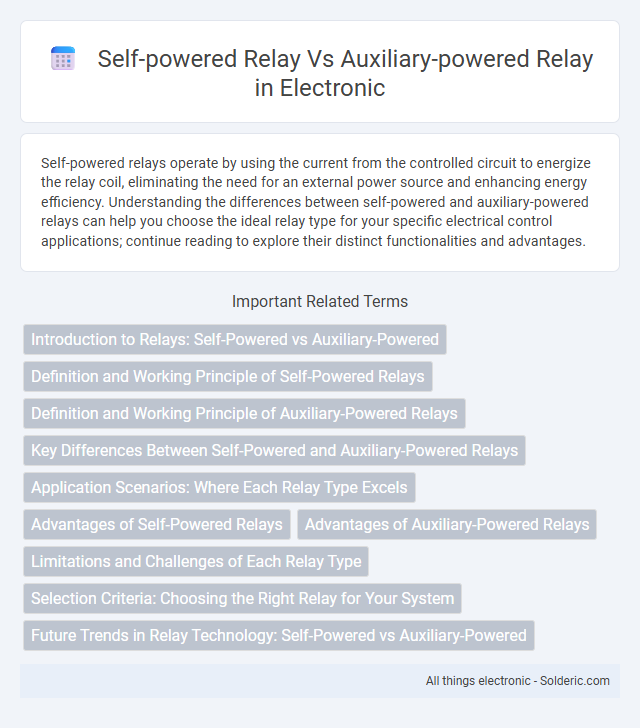Self-powered relays operate by using the current from the controlled circuit to energize the relay coil, eliminating the need for an external power source and enhancing energy efficiency. Understanding the differences between self-powered and auxiliary-powered relays can help you choose the ideal relay type for your specific electrical control applications; continue reading to explore their distinct functionalities and advantages.
Comparison Table
| Feature | Self-Powered Relay | Auxiliary-Powered Relay |
|---|---|---|
| Power Source | Uses input signal energy | Requires external auxiliary power |
| Energy Efficiency | More energy-efficient | Consumes additional power |
| Application | Low-power control circuits | High-power or complex control systems |
| Reliability | Dependent on input signal strength | Stable operation with constant power |
| Cost | Generally lower cost | Higher cost due to auxiliary components |
| Complexity | Simpler design | More complex wiring and components |
| Response Time | Usually faster response | May have slight delay due to power stabilization |
Introduction to Relays: Self-Powered vs Auxiliary-Powered
Self-powered relays operate using the inherent energy within the control circuit, eliminating the need for an external power source, which enhances efficiency and reduces wiring complexity. Auxiliary-powered relays require an independent power supply to energize the coil, providing consistent performance in applications where reliable switching is critical. Understanding the differences between these relays helps optimize system design by selecting the appropriate relay type based on power availability and control requirements.
Definition and Working Principle of Self-Powered Relays
Self-powered relays operate without an external power source, deriving energy directly from the input signal to activate the switching mechanism, making them ideal for applications with limited power availability. Their working principle relies on energy conversion from the control circuit's own current or voltage, enabling the relay coil to generate the magnetic field required for operation. You benefit from increased energy efficiency and simplified wiring when using self-powered relays compared to auxiliary-powered relays that need a separate power supply.
Definition and Working Principle of Auxiliary-Powered Relays
Auxiliary-powered relays operate using an independent power source separate from the control circuit, enabling reliable switching and isolation in electrical systems. These relays function by energizing a coil with auxiliary voltage, creating a magnetic field that actuates the switch contacts, allowing current to flow through the output circuit. This design ensures stable operation in applications requiring consistent power regardless of the control signal status.
Key Differences Between Self-Powered and Auxiliary-Powered Relays
Self-powered relays operate directly from the input signal without requiring an external power source, making them ideal for energy-efficient and remote applications. Auxiliary-powered relays rely on an additional power supply to energize the coil, allowing for greater control and higher load capacities. Key differences include energy consumption, with self-powered relays offering lower operational costs, while auxiliary-powered relays provide enhanced reliability and versatility in complex electrical systems.
Application Scenarios: Where Each Relay Type Excels
Self-powered relays excel in remote or battery-operated systems where external power supply is limited, making them ideal for wireless sensor networks and portable devices. Auxiliary-powered relays are best suited for industrial automation and control panels where stable power sources ensure reliable operation and faster switching performance. Your choice depends on the availability of power and the specific demands of the application environment.
Advantages of Self-Powered Relays
Self-powered relays offer the advantage of operating without the need for an external power source, ensuring higher reliability in remote or power-sensitive applications. They reduce wiring complexity and associated costs by drawing energy directly from the control circuit. Your system benefits from increased efficiency and lower maintenance requirements, making self-powered relays ideal for energy-saving designs.
Advantages of Auxiliary-Powered Relays
Auxiliary-powered relays offer enhanced reliability by maintaining consistent coil voltage independent of the controlled circuit, ensuring stable operation under varying load conditions. They provide greater flexibility in control circuit design, allowing integration with different voltage levels and improved response times due to dedicated power supply. These relays also enhance safety by isolating the control circuit from high power circuits, reducing the risk of electrical interference and potential damage.
Limitations and Challenges of Each Relay Type
Self-powered relays face limitations such as restricted operational voltage range and dependence on the energy harvested from the controlled circuit, which can lead to inconsistent performance under low power conditions. Auxiliary-powered relays rely on an external power source, creating challenges related to power supply reliability and increased installation complexity. Both relay types encounter issues with response time delays and susceptibility to electrical noise, impacting overall system stability.
Selection Criteria: Choosing the Right Relay for Your System
Selection criteria for self-powered relays emphasize energy efficiency and system simplicity, suitable for low-power or energy-harvesting applications where external power sources are limited. Auxiliary-powered relays offer greater reliability and consistent performance in systems with stable power supplies, ensuring faster switching and higher load capacity. The choice depends on the availability of power, required switching speed, and the complexity of the control circuitry in the system design.
Future Trends in Relay Technology: Self-Powered vs Auxiliary-Powered
Future trends in relay technology emphasize increased energy efficiency and smart automation capabilities, with self-powered relays gaining traction due to their ability to operate without external power sources by harvesting energy from the control signal. Auxiliary-powered relays continue to evolve with integrated diagnostics and communication interfaces, enabling enhanced monitoring and remote control in industrial automation systems. Advancements in semiconductor materials and IoT integration drive the shift towards hybrid relay solutions combining the reliability of auxiliary power with the sustainability of self-powered designs.
self-powered relay vs auxiliary-powered relay Infographic

 solderic.com
solderic.com